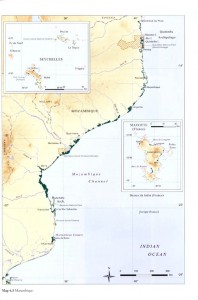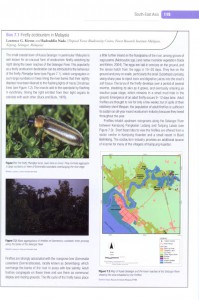 What is a mangrove, what sort of habitat does it provide, and what might you find living there?
What is a mangrove, what sort of habitat does it provide, and what might you find living there?
The term mangrove covers both a group of plants, and the habitats they build. The plants are a broad group which consists of about 70 species and hybrids, including a palm and 3 large ferns, the rest being trees. They have all evolved to live in the intertidal zone, and many have some quite dramatic adaptations – physiological mechanisms to keep out or to remove salt; strange roots which hold them up in soft soils, and others to allow air to the roots in the waterlogged muds; even reproductive tricks, like vivipary, to give young plants a headstart in a tough environment.
And wherever they grow they form a very distinctive habitat which is sometimes just a few small patches in a narrow intertidal zone, but sometimes extends for hundreds of kilometers around deltas and along estuaries.
The World Atlas of Mangroves, published by Earthscan, is a huge undertaking with you at the helm as lead author. What are your credentials? Who were your colleagues?
I think it’s taken about 5 years. Leadership of the whole project was run by the wonderful International Society for Mangrove Ecosystems, a small but very active NGO based in Japan, with funds from the International Tropical Timber Organization. Mami Kainuma, one of the co-authors, works with ISME. Also, at its heart, it’s a book rich with maps – and that work fell to two other organisations: FAO in Rome and UNEP-WCMC in Cambridge – and many fantastic colleagues in both organisations.
I wrote an earlier mangrove atlas with ISME which came out in 1997. In fact the two works are almost incomparable. The 1997 work was the best we could do with limited resources. It’s not bad, but this work is so much more than just a new edition – we’ve got globally consistent, detailed maps; we reviewed 1400 references for the text; we have the first ever range maps for all species…
With mangroves disappearing three to four times faster than land-based forests, what is being done to address the situation?
I think the issue is largely a product of where they are situated. The coastal zone has faster-growing populations and mangroves are on a sort of front line, on valuable land which can be readily and easily converted for agriculture, aquaculture or urban development.
But quite a lot is being done. We estimate that a quarter of all remaining mangroves are in protected areas, while additional areas are in places where there is sustainable management. The realization of just how valuable mangroves are has also driven huge efforts at mangrove restoration and plantation in many countries – over 2% of the world’s mangroves are restored.
What are the main problem or priority areas for mangrove conservation?
Communication. I think the case for mangrove conservation is rock-solid. More so than for some other habitats where direct dollar values for goods and services can sound a little tortured or unconvincing. But many still don’t know it, so mangroves are still suffering from a poor press as unproductive wastelands, and from poor accounting, as short-term profits are being used to persuade losses with often dire long-term consequences.
But it’s not all bad news? What are some of the success stories?
Matang forest in Malaysia, and the Sundarbans in Bangladesh and India, are among the longest-running tropical forestry operations in the world. They are plantations of a sort, though much reafforestation is just natural growback. But in both places for well over a century thousands or even tens of thousands of people have benefitted from timber products and fisheries, while the wildlife remains abundant, showing that we can work alongside nature.
Mangroves are also robust survivors. Given half a chance they’ll recover. They don’t appear to be stressed by warming temperatures, and if they can migrate inland then sea level rise might not stress them too much either. Get things right and they are going to help us to adapt to climate change AND keep local communities going with other goods and services.
The World Atlas of Mangroves is a global overview, and this is a focus we see increasingly in conservation and ecology with developments such as remote sensing. What are the benefits and the limitations of this kind of approach?
In an increasingly global world they help us to get things in perspective. For those working at national or local levels they offer a context for that work. They enable arguments to be made, and I’d like to think they also enable connections – that people working South America might realize the bonanza to be made from ecotourism, or sustainable harvesting. They also help those who deal with issues at the international level – in the case of mangroves to make the case for their importance – in climate change adaptation, carbon sequestration, rural livelihoods, offshore fisheries. Of course its not a book to be used for navigation! The maps are good, but not that good, and it’s always important for people like me to remember that books like this are really written by the thousands of experts who live and work “on the ground”.
You have commented on the “extraordinary synergies between people and forests”. How would humanity be affected by a substantial decrease in the world’s remaining mangroves?
Of course, many in the west wouldn’t notice, and the world’s economies might not notice, but mangroves are right there in the front line for many of the world’s poorest. There would be declines in livelihood, and in food and fuel supplies in many of the world’s poorest tropical coastal areas. A more subtle impact would be that of increased vulnerability. These same people, and others, even in coastal towns and cities, would become more exposed to risk from storms, flooding and the more subtle encroachment of sea level rise. Mangroves won’t stop these things, and its hard to pin exact numbers on the services, but the evidence that they help significantly is now very solid.
I assume you have visited many mangroves in your travels – what is it like to experience being in, on or around a mangrove? Any interesting stories from a field marine ecologist?
I just love getting into mangroves, wherever I am. It’s an escape to another world. To scramble, monkey-like through the 3-dimensional landscape of roots, with feet never touching the ground, or to paddle a canoe through apparently endless narrow channels, or even, in some places to snorkel at high tide and to watch fish at home in

an underwater forest. And then to stay still and watch to intense activity across the full spectrum of marine and terrestrial life. There’s a sort of magic about it, it seems to break all our preconceptions of what the coast should be like, or the sea, or a forest!!!
What part do you see the Atlas playing in highlighting the cause of mangrove conservation?
There’s a lot of information out there about the importance and value of mangroves, but perhaps it’s suffered from being piecemeal. The case might have been made that each story was a one-off. This time we’ve read 1400 sources and had review comments from over 100 people. It’s no longer possible to ignore the patterns and I hope that it might be used, by academics, teachers, policy experts and NGOs, to really make the case. Mangroves are critical resources.
What would you suggest as the most important next action the world’s conservation organisations and political leaders should take if we are to see our mangroves flourish and to secure a happy future for their inhabitants and dependents?
I think for some, conservation organizations embracing habitat restoration and active plantation might be something of a new direction. For others working to educate local communities on the values of mangroves, or to help them defend their mangrove from clearance or conversion might be new ground. For sure we could always do with more protected areas, but actually in this case the holistic vision might take us beyond that and into thinking about protection in other ways, such that we halt losses completely and start to increase habitat areas.
Another new direction will be seriously planning for climate change. That will mean thinking about what lies behind the mangroves and planning for movements and migrations as sediments move, and new land is inundated.
The World Atlas of Mangroves is available now from NHBS






























